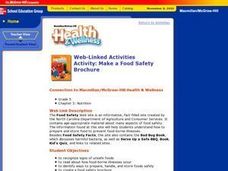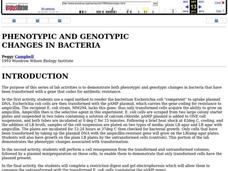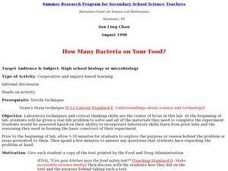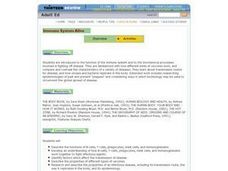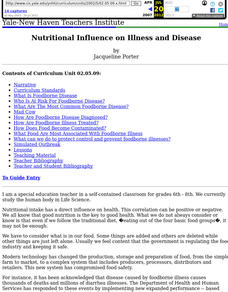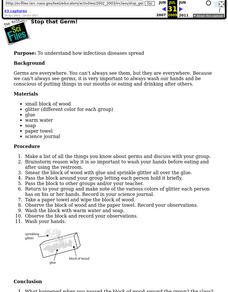Curated OER
Make a Food Safety Brochure
Students create brochures that inform their families how to prepare and store food to prevent food-borne illnesses. They research food safety facts and proper food-handling techniques on the internet.
Curated OER
Are Nanobacteria Alive: Sample Socratic Questions
Students comprehend the definition and uniqueness of life and its complexities. They examine what characteristics constitute a living organism. Students recognize the extent of the role nanobacteria play in the movement and molding of...
Curated OER
Nitrogen Fixation, OR What a Gas!
Young scholars illustrate the adaptation and co-evolution of organisms. They examine set up an experiment to determine the effect of adding the Rhizobium bacteria to a group of legume seeds.
Curated OER
Using A Winogradsky Column to Analyze Microbial Communities
Students use easily obtained materials to study ecological succession in a microbiological community. This investigation is appropriate for a variety of age groups. Elementary Students be fascinated by the changes occurring over time...
Curated OER
Demonstrating an Epidemic
Young scholars use an experiment that allows them to experience a small scale "epidemic", demonstrating the ease with which disease organisms are spread. Students determine the originator of the epidemic. They transfer live bacteria by...
Curated OER
Smallest Thing
Students compare characteristics of myobacteria and viruses to determine which is the smallest life form. They read and discuss an article that presents different viewpoints on the definition of life to determine their own viewpoint.
Curated OER
Mutations--Preexisting or Acquired?
Students explore the reasoning and experimental approaches to mutations. They expose a culture of E. coli to virulent bacteriophage and observe whether mutations of the cells existed previously or if the bacteria mutated as a response...
Curated OER
Phenotypic and Genotypic Changes in Bacteria
Students investigate a rapid method to render the bacterium Escherichia coli "competent" to uptake plasmid DNA. They demonstrate the phenotypic changes associated with transformation. They perform a cell resuspension from the...
Curated OER
TE Activity: How Fast Can a Carrot Rot?
Learners experiment to define which environmental factors favor decomposition by soil microbes. They decompose carrots in dirt, weigh the carrots periodically to determine how long it takes. They look at how engineers use this type of...
Curated OER
How Many Bacteria on Your Food?
Students discuss and conduct a food safety experiment which looks at bacteria and food poisoning. They swab the other area of some food and grow bacteria in an agar plate.
Curated OER
Determining the Effectiveness of Handwashing
Students participate in an experiment in which they grow bacterial colonies. They examine the effects of antibiotics killing the germs. They discuss their findings to end the lesson.
Curated OER
How To Culture Bacteria in the Laboratory
Students participate in an experiment in which they culture bacteria in a lab setting. They record their observations and analyze the data. They answer comprehension questions to end the lesson plan.
Curated OER
A Virtual Visit to the Microbial Zoo
Students complete a WebQuest on viruses, bacteria, and protists. They explore various websites, and answer discussion questions.
Curated OER
Immune System Alive
Young scholars examine the function of the immune system. They read and discuss text, complete a K-W-L chart, sequence photos of white blood cells encountering bacteria, develop an outline, and write an essay.
Curated OER
Naked to the Eye
Sixth graders conduct a variety of experiments that enable them to investigate bacteria. They use microscopes, prepared slides, video, moldy bread and pond water to observe types of bacteria and how bacteria interacts with the...
Curated OER
Microbe Experimentation: Sour Milk
Sixth graders design and conduct an experiment with milk to investigate how temperature affects bacteria growth. They, in groups, construct a hypothesis, perform the experiment and then record and present the results.
Curated OER
Classy
Students explore the classification system in this seven lessons unit. The diversity of life forms and their characteristics are examined using a microscope. Kingdoms, classes, and families are investigated.
Curated OER
Biofilms Are Everywhere
Students research biofilms and create brochures. They role play as advertising firm members assigned to educate the general public about biofilms. They create "wanted dead or alive" posters about harmful and helpful biofilms respectively.
Curated OER
A Variety of Very Safe Veggies
Learners study viruses and bacteria that can contaminate vegetables. They examine how vegetables can be preserved and what farmers might do to keep vegetables safe. They examine with pickling as a way to keep vegetable preserved safely.
Curated OER
Soil Microbiology- Nitrogen cycle
Students take a virtual trip to a Catfish Aquaculture Pond and analyze soil bacteria to determine how many nitrogen cycle bacteria are present. They graph the number of colonies present and use data to determine ammonium levels in the soil.
Curated OER
The Last Great Canal
Students read about a cholera outbreak in the 1840's. They read maps, predict how cholera moved throughout the country and participate in a lab activity that demonstrates how disease is spread. They compare cholera through time.
Curated OER
Nutritional Influence on Illness and Disease
Students examine nutritionally related diseases and illnesses, evaluating studies and developing topics for a science fair project. They investigate bacteria, researching how it can be harmful or helpful, and create illustrated displays.
Curated OER
Gregory Carter
Pupils explore how the immune system, fights a war with a pathogenic organism: one of the many bacteria, viruses, and protozoans that can infect our bodies and cause disease.
Curated OER
Stop that Germ!
Students experiment with glitter to explain the importance of washing hands and how germs are distributed. After a lecture/demo, students perfom a simple experiment which clearly demonstrates how germs are spread.


